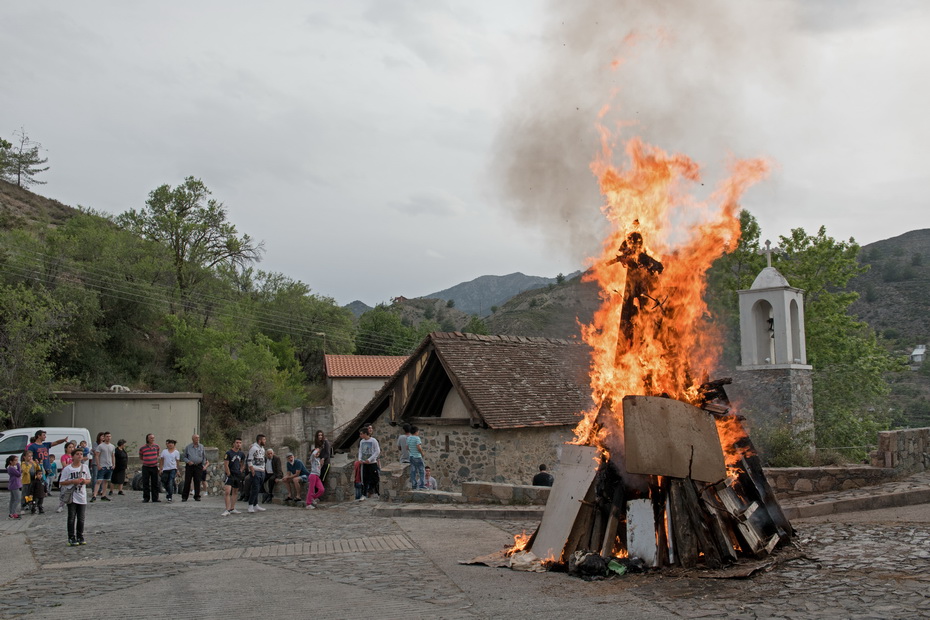Easter Traditions in Cyprus
Easter is considered to be the one of the biggest religious celebrations of the Greek Orthodox Church. It is a movable holiday, and always observed on the first Sunday following the full moon of the Spring Equinox. The week leading up to Easter Sunday is known as the Holy Week, and it is a special one for residents of Cyprus. It is a time when spring is finally in the air, and every home is filled with the delicious aromas of traditional Cypriot baking, as families prepare to come together for Sunday’s big feast.
Here are some of the unique Easter traditions you won’t want to miss out on during this week-long festive period.
Baking up a storm

Thursday of Holy Week is the day when grandmothers and housewives pull up their sleeves and start pummelling large vats of dough to make traditional Easter cakes and breads. Families join forces to make ‘flaounes,’ which are small loaves of cheese bread, sprinkled with mint and sesame and sometimes raisins, and ‘tsourekia,’ a sweet, fluffy braided Easter bread.

Eggs are also dyed on this day, in the traditional red colour, which symbolizes the blood of Christ. However, despite all the hard work spent baking, those who are still fasting are unable to taste the delicious fruit of their labours until Easter Sunday!
Spring Decorating

Since Easter is usually celebrated at the time when spring sunshine begins to usher in the island’s first blooms after the cold winter spell, families take this opportunity to give their homes a spring makeover. Meadows are filled with dazzling hues as bright red poppies, golden daisies and violet anemones begin to sprout, signifying the arrival of Easter.

These colours are replicated in the Easter décor of family homes, as bouquets liven up window sills and kids turn their Easter eggs into a craft project, adorning them in fun, colourful patterns and designs.
Evening Church Services

The main church services during Easter are held in the evening, so visitors to the island may be surprised to see empty streets on Friday and Saturday nights. Holy Friday is the day of the ‘Epitafios,’ or ‘Holy Sepulchre,’ where a flower-bedecked four-poster canopy is carried into the streets for a solemn procession, symbolizing the burial procession of Christ. On Holy Saturday, people congregate at their local church for Midnight Mass to celebrate the Resurrection of Christ. This is represented by the lighting of candles with the Holy Light, which is believed to arrive straight from Jerusalem. Many people take this sacred light home with them, and use their candle to smudge the sign of a cross at the top of their doorframe, as a symbol to bless their home.
Lighting the ‘Lambratzia’

During Saturday’s Midnight Mass, many communities light huge bonfires in the church yard, a ritual which signifies the burning of Judas Iscariot. Though many churches in town have foregone this rather hazardous tradition, it is still alive and well in most village churches in Cyprus, where local children can be seen collecting wood and other discarded, flammable items in an effort to create the biggest blaze. These fires are always overseen by local authorities, though the loud pops from the firecrackers that sometimes get tossed into the flames do sometimes tend to alarm unknowing bystanders, so beware!
Breaking the fast

Those who have faithfully fasted throughout the entire period of Lent, first break their fast late on Saturday evening, after returning from Midnight Mass, with a steaming bowl of ‘avgolemono’ soup. This is a tangy lemon and egg soup which is often accompanied by boiled chicken.

The eggs which had been dyed red on Thursday are also cracked at this time, in a fun competition where the ‘winner’ is the person who is left with the sole un-cracked egg. This breaking of the eggs is symbolic of the Resurrection of Christ.
A meat-eaters’ feast!

Happy Easter! On Easter Sunday, the most joyous of festive occasions, get ready to eat! And then eat some more. Family and friends gather together for a lavish meal that usually consists of roast lamb or ‘souvla,’ – meat barbecued on an open coal fire – and an abundance of cakes, sweets and wine. In fact, the smell of outdoor barbecues permeates the entire neighbourhood, while traditional songs are played at full volume, mingling with the happy sounds of cheer and laughter.
Easter celebrations wrap up by Tuesday evening, but until then, the spirit of joy and merriment can be seen and felt throughout the island. Everyone is greeted with a warm ‘Christos Anesti’ (Christ is Risen) or ‘Chronia Polla’ (Many Happy Returns!) so don’t hesitate to join in and celebrate along!
